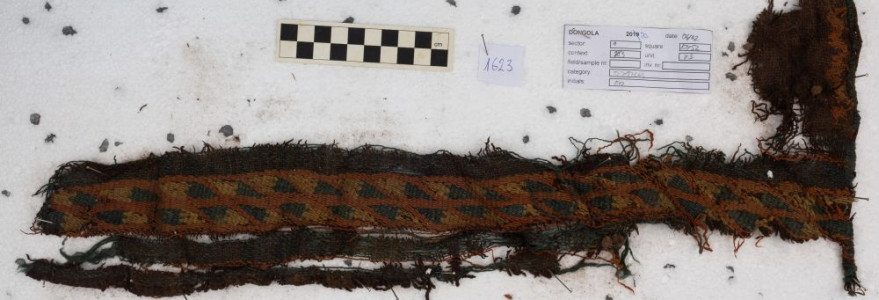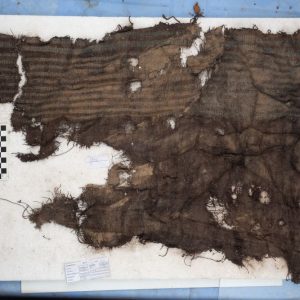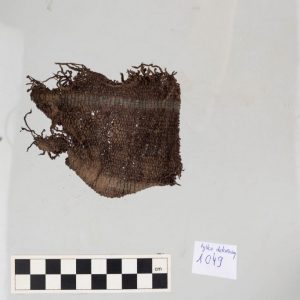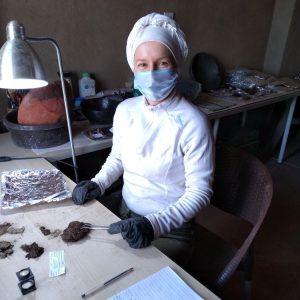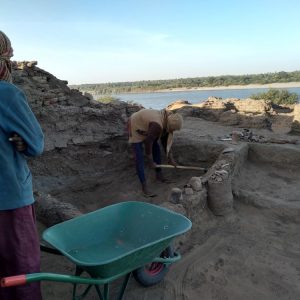Blue was among the most popular clothing colours of the inhabitants of Old Dongola. They wore mainly cotton and wool, according to research by chemists and archaeologists from the University of Warsaw. The results of their analysis of fabrics excavated on the territory of present-day Sudan were published in journal “Archaeometry”.
“Archaeologists conducting research in Africa often face lack of written sources since the tradition of oral transmission of information prevailed there. The daily life of the inhabitants of Old Dongola – including local textile production and dyeing – can be learned by studying the material culture of the community,” Dr Magdalena Woźniak of the Polish Centre for Mediterranean Archaeology (CAŚ) at the University of Warsaw, says.
An interdisciplinary team from the University of Warsaw examined seventeen fragments of textiles dating to the 16th, 17th and 18th centuries. The fabrics come from the city which were the centre of life in Dongola. Most Sudanese textiles studied by archaeologists come from cemeteries, so the discovery is quite unique.
Popular blue
A collaboration between archaeologists and chemists has identified the sources of dyes and the dyeing techniques once used by the people of the area. The research indicates that both plant and animal dyes were used. The colour blue was very popular in medieval Dongolia. Cotton – exported even from India – was only dyed when it was delivered to Egypt.
“The research we are doing now indicates that blue was an important colour. It has a long history in the Nile Valley, dating back to antiquity. Perhaps it was thought to serve as a protection against evil,” Dr Woźniak says, adding, “Sometimes clothes made of undyed cotton were patched with blue-dyed fabrics, which means that this material was constantly available and important to the inhabitants in Dongola.”
The researchers also looked at the patterns used to decorate clothes made from the most common raw materials: cotton and wool. “Cotton fabrics are decorated at the edges. This is usually between one and twelve strips of pattern. Being able to afford more dyed and decorated fabric was an indication of wealth of the people who wear them,” Dr Magdalena Woźniak describes. Woollen fabrics, more often than cotton ones, were decorated with green or red. Blue stripes were also a popular pattern.
The researchers noted that garments made of cotton were sewn, while wool garments show traces of mending, reparation, but not sewing. Wool garments were therefore simpler, often one-piece.
Collaboration between chemists and archaeologists
Chromatographic analyses were used in the research, which allowed to determine the original colours of the materials altered by environmental factors, such as light or moisture. The origin of the dyes was both plant and animal.
“By seeing the fabric, I can determine its colour but I do not know what exactly it was dyed with. Researchers from the Faculty of Chemistry at the University of Warsaw under the direction of Prof. Magdalena Biesaga made it possible to check this,” Dr Woźniak explains. “Now, I have knowledge of what dyes the inhabitants of the Nile Valley had access to and what technology they mastered to obtain the colours. Each dye requires a different technique. Some, for example, are applied using a mortar with metal salts,” the researcher explains.
The research was facilitated by the dry climate of the Nile Valley, thanks to which the fabrics are well preserved organically: they remain quite soft and the colours are clearly visible.
Dr Magdalena Woźniak from the CAŚ UW and Prof. Magdalena Biesaga, Prof Tomasz Gierczak and Dr Bartłomiej Witkowski from the Faculty of Chemistry at the UW participated in the research.
A team of analytical chemists from the UW’s Faculty of Chemistry is working with representatives of cultural and scientific institutions to identify sources and markers of natural dyes used in the past to dye textiles. Their work supports the research of archaeologists, conservators and art historians.
The excavations at the Old Dongola site are being carried out under a European Research Council grant. The chemical analyses were carried out under a grant from the “Excellence Initiative – Research University” programme.
Publication details
Magdalena M. Woźniak, Bartłomiej Witkowski, Tomasz Gierczak, Magdalena Biesaga, “First dye identification analyses conducted on textiles from Old Dongola (Sudan, 17th-18th centuries CE)”, Archaeometry (2023): http://doi.org/10.1111/arcm.12930



